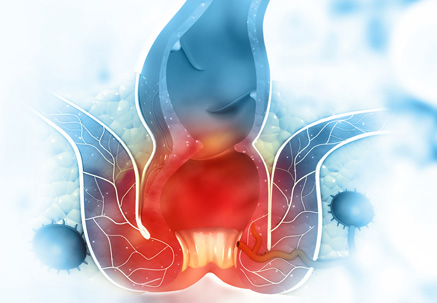What is an anal abscess?
An anal abscess is an infected cavity filled with pus found near the anus or rectum.

A patient who feels ill and complains of chills, fever and pain in the rectum or anus could be suffering from an anal abscess or fistula. These medical terms describe common ailments, about which many people know little.
An anal abscess is an infected cavity filled with pus found near the anus or rectum.
An anal fistula, almost always is the result of a previous abscess, and is a small tunnel connecting the anal gland from which the abscess arose to the skin of the buttocks outside the anus.
An abscess results from an acute infection of a small gland just inside the anus, when bacteria or foreign matter enters the tissue through the gland. Certain conditions – colitis or other inflammation of the intestine, for example – can sometimes make these infections more likely.
After an abscess has been drained, a tunnel may persist connecting the anal gland from which the abscess arose to the skin. If this occurs, persistent drainage from the outside opening may indicate the persistence of this tunnel. If the outside opening of the tunnel heals, recurrent abscess may develop.
Symptoms of both ailments include constant pain, sometimes accompanied by swelling, that is not necessarily related to bowel movements. Other symptoms include irritation of skin around the anus, drainage of pus (which often relieves the pain), fever, and feeling poorly in general.
No. A fistula develops in about 50 percent of all abscess cases, and there is really no way to predict if this will occur.
An abscess is treated by draining the pus from the infected cavity, making an opening in the skin near the anus to relieve the pressure. Often, this can be done in the doctor’s office using a local anesthetic. A large or deep abscess may require hospitalization and use of a different anesthetic method. Hospitalization may also be necessary for patients prone to more serious infections, such as diabetics or people with decreased immunity. Antibiotics are not usually an alternative to draining the pus, because antibiotics are carried by the blood stream and do not penetrate the fluid within an abscess.
Surgery is necessary to cure an anal fistula. Although fistula surgery is usually relatively straightforward, the potential for complication exists, and is preferably performed by a specialist in colon and rectal surgery. It may be performed at the same time as the abscess surgery, although fistula often develop four to six weeks after an abscess is drained sometimes even months or years later. Fistula surgery usually involves cutting a small portion of the anal sphincter muscle to open the tunnel, joining the external and internal opening and converting the tunnel into a groove that will then heal from within outward. Most of the time, fistula surgery can be performed on an outpatient basis – or with a short hospital stay.
Discomfort after fistula surgery can be mild to moderate for the first week and can be controlled with pain pills. The amount of time lost from work or school is usually minimal.
Treatment of an abscess or fistula is followed by a period of time at home, when soaking the affected area in warm water (sitz bath) is recommended three or four times a day. Stool softeners may also be recommended. It may be necessary to wear a gauze pad or mini-pad to prevent the drainage from soiling your clothes. Bowel movements will not affect healing.
If properly healed, the problem will usually not return. However, it is important to follow the directions of a colon and rectal surgeon to prevent recurrence.